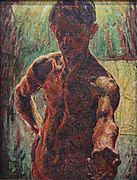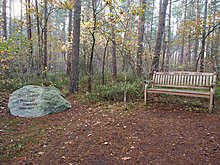Fritz Flebbe
Fritz Flebbe (born August 4, 1893 in Harburg (Elbe) , † May 27, 1929 in Müden (Örtze) ) was a German painter and graphic artist .
biography
Fritz Flebbe was born as the son of a railway official in Harburg / Elbe. After attending elementary and middle school , he first began a business apprenticeship. In 1912/13 he made the decision to train as a painter against his parents' wishes. On May 1, 1915 he became a conscientious drafted and fought in the First World War at the front in northern France and Russia . After a serious head wound on June 20, 1916, after recovering , he was transferred to a map office in March 1917 and to a surveying department of the 1st Army on May 15, 1917 . On November 13, 1918, he was released from the German Army . In addition to his head injury, Flebbe returned from the war with a serious lung disease to Harburg, to a small apartment at Wilhelmstrasse 6. The illness often forced him to interrupt his work for months , also as a result of the necessary visits to sanatoriums . In February 1920 his first wife (Ina), with whom he has a daughter (Isolde), died of flu. From mid-1923 to spring 1926 Flebbe lived and worked mainly in Goslar and Braunschweig. Through his former teacher Arthur Illies he was able to make contacts here. Among other things, to the manufacturer and art patron Friedrich Borchers and to his friend the geographer Ewald Banse , whom he had already met during the war. During that time he lived with Margarethe Wesenick, whom he married in 1926. In the same year his second daughter Mechthild was born. Fritz Flebbe was a member of the Hamburg Artists' Association from 1832 .
In May 1926 Flebbe moved to the Lüneburg Heath , to Müden (Örtze). Here the climate offered good conditions for his lung disease. This change of location was arranged by a spa guest in Bad Rehburg . Flebbe cured there from autumn 1925 to spring 1926. In Müden he first lived in the house of the roofer Friedrich Stelter and in 1927 he moved to August Cassier's house (today Unterlüßer Str. 24). There he was able to work in a more spacious studio for the first time. As a result of his war injuries, Flebbe died at the age of 35 in the evening hours of May 27, 1929. He was buried on May 30, 1929 in the old cemetery in Müden. His friend Ewald Banse gave the funeral speech.
education
From 1914 to May 1, 1915, attended the State School of Applied Arts in Hamburg . He was a student of Arthur Illies , the co-founder of the Hamburg Artists' Club . He has to drop out of training when he is called up for military service.
Work
First of all, his work is shaped by the influence of his teacher Illies. During the war, he got to know the graphic technique of lithography in the surveying center of the 1st Army . He then applied this technique to drawing portraits and figures. In the spring of 1918 he published a newspaper “ Die Insel ” with a print run of 60 copies, which was also produced lithographically. After the end of the war, he took up religious themes in his paintings, also influenced by his own illness. Examples include The Return of the Prodigal Son (1914 and 1927), Flagellation (1922) and Lamentation (1928). But he was also a sought-after portrait painter . But mainly he was concerned with landscape paintings . Flebbe painted both the surrounding area and the landscape that he got to know during his travels and stays in sanatoriums. He called himself an expressionist . After moving to Müden, a new artistic phase began for Flebbe. His pictures brighten and he takes up themes from rural life. The pictures of the southern heath show this in a characteristic way, with heather, birch and juniper, but also meadows, forests and fields at different times of the year. He created a total of around 220 paintings, 250 drawings and watercolors as well as 50 lithographs.
- Works by Fritz Flebbe
Awards
- A street in Hamburg-Wilstorf was named after him.
- In Müden (Örtze) there is a path named “Fritz-Flebbe-Twiete” after him.
Exhibitions
In 1930, after his death, his painter friends Hugo Friedrich Hartmann and Friedrich Wilhelm (Frido) Witte organized a memorial exhibition in Lüneburg . In the same year an exhibition in his memory is shown in Hamburg-Harburg. This is followed by exhibitions in Lüneburg (May 1949), Hamburg-Harburg (1951), Braunschweig (1983), Müden (1984) and Unterlüß (1992 and 2013/14). Works by the artist are owned by the Hamburger Kunsthalle , the Braunschweigisches Landesmuseum , the Städtisches Museum (Braunschweig) , the Bomann Museum in Celle, the Museum for the Principality of Lüneburg and the Albert König Museum in Unterlüß .
Works in museums and collections (selection)
- River landscape (1911), Albert-König-Museum Unterlüß
- Hand grenade launcher (1917), lithograph, Albert-König-Museum Unterlüß
- Small study head (1917), lithograph, Albert-König-Museum Unterlüß
- Two friends - two heads (1917), Albert-König-Museum Unterlüß
- Two friends - two heads (1917) Hamburger Kunsthalle
- Sehnsucht (1918), lithograph, Hamburger Kunsthalle
- Self-portrait study (1918), chalk drawing, Hamburger Kunsthalle
- Prayer (1918), lithograph, Albert-König-Museum Unterlüß
- Pain (1918), lithograph, Albert-König-Museum Unterlüß
- Sturm (1918), lithograph, Albert-König-Museum Unterlüß
- Clenched hand (1918), lithograph, Albert-König-Museum Unterlüß
- Visionary portrait (around 1919), lithograph, Albert-König-Museum Unterlüß
- Portrait of Georg Hölscher (1919), lithograph, Albert-König-Museum Unterlüß
- Double portrait of Fritz Flebbe and Ewald Banse (1921), Landesmuseum Braunschweig
- Ewald Banse at his desk (1922), Braunschweig State Museum
- Works council (1922), Helms-Museum Hamburg-Harburg
- Flagellation (1922), Helms-Museum Hamburg-Harburg
- Ewald Banse with hat (1923), Braunschweig Municipal Museum
- Portrait of Bernhard Günther (1924), City of Goslar
- Light Blessing (1925), oil on canvas, Albert-König-Museum Unterlüß
- Heideweg in autumn (around 1925), Helms-Museum Hamburg-Harburg
- Autumn evening (after 1925), oil on canvas, 50.5 × 65.5 cm, Helms-Museum Hamburg-Harburg
- Weg durch die Heide (after 1925), oil on canvas, 52 × 40 cm, Albert-König-Museum Unterlüß
- Vision at Braunschweig Cathedral (before 1926), lithograph, Frido Witte Foundation Lüneburg
- Portrait of August Helms (1926), Helms-Museum Hamburg-Harburg
- Portrait of Hermann Maul (1926), Helms-Museum Hamburg-Harburg
- Heideweg (around 1926), oil on canvas, 51 × 66 cm, Celle district
- Summer Heideweg (after 1926), Helms-Museum Hamburg-Harburg
- Alter Bauer (1927), Helms Museum Hamburg-Harburg
- Heideweg near Müden (around 1927), Bomann Museum Celle
- Self-portrait (1928), Helms-Museum Hamburg-Harburg
- Portrait of Ewald Banse (1928), Braunschweig State Museum
- Old farmer's wife (1928), Museum for the Principality of Lüneburg
- Self-Portrait with Palette (1928), City of Lüneburg
- Isolde Flebbe (1929), pencil drawing, Celle district
- Landscape photo (undated), Helms-Museum Hamburg-Harburg
- River landscape in the heather (undated), Helms-Museum Hamburg-Harburg
literature
- Klaus Homann: Painters see the Lüneburg Heath. Albert-König-Museum, Unterlüß 2008, ISBN 978-3-927399-39-6 .
- Antonio Caprano, Sabine Pinkepank-Appel (ed.), Volker Probst (arrangement): Fritz Flebbe painter and graphic artist 1893–1929–1993. Atelier Diptychon, Groß Lafferde 1993, ISBN 3-930146-01-0 .
Individual evidence
Web links
- Flebbe biography at netPlanet Harburg
- Paintings, lithographs and drawings by Flebbe at netPlanet
- Have a great time with Artplacement
| personal data | |
|---|---|
| SURNAME | Flebbe, Fritz |
| BRIEF DESCRIPTION | German painter and graphic artist |
| DATE OF BIRTH | 4th August 1893 |
| PLACE OF BIRTH | Hamburg-Harburg |
| DATE OF DEATH | May 27, 1929 |
| Place of death | Müden (Örtze) , Lower Saxony |










